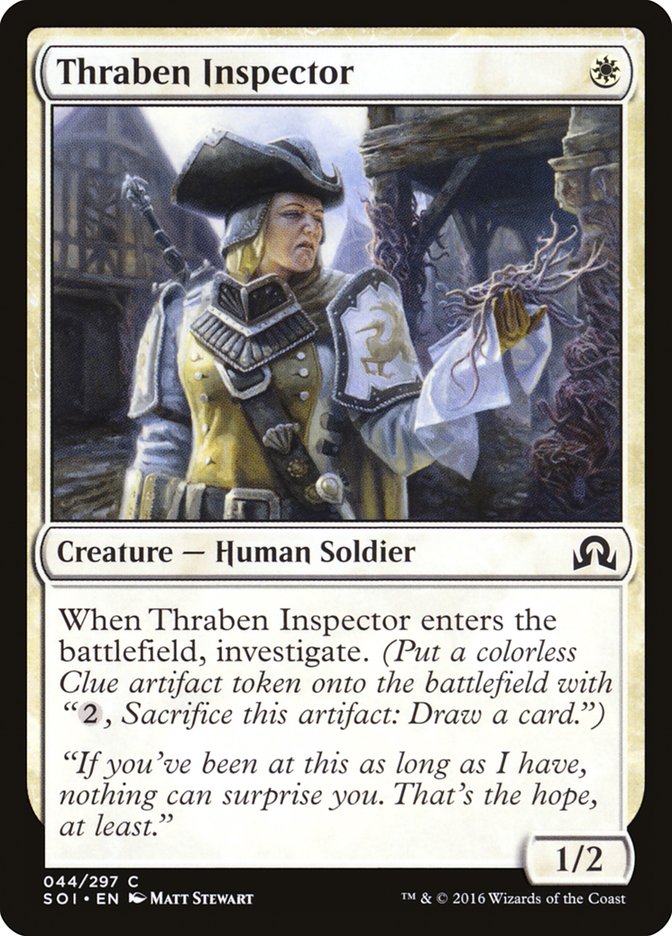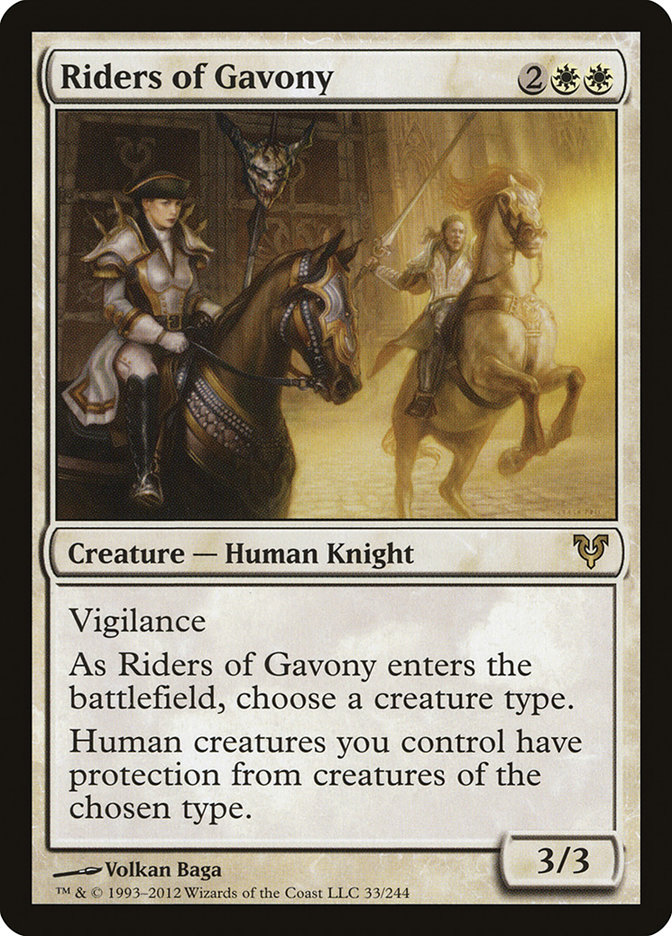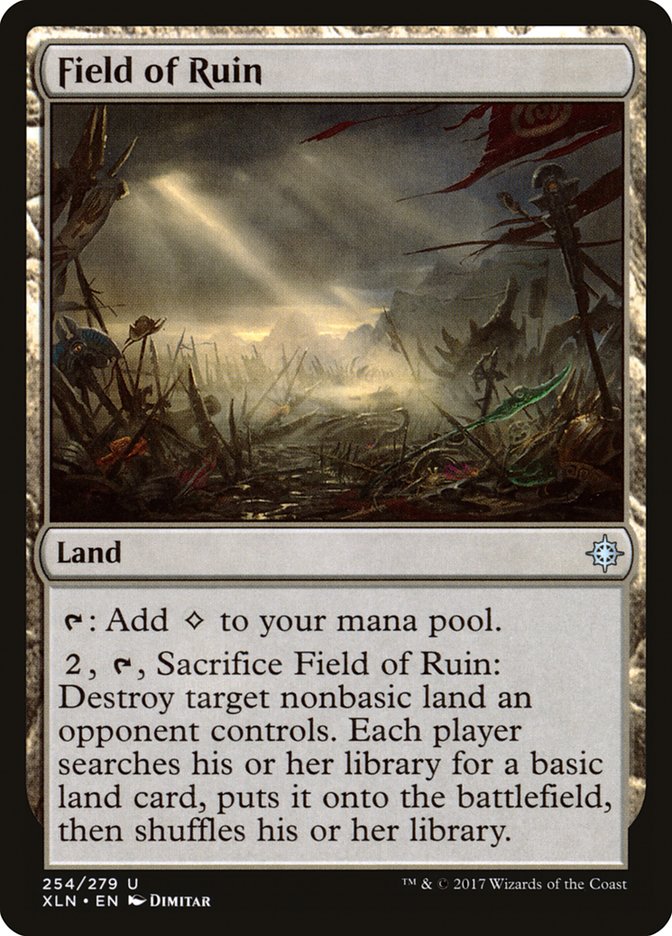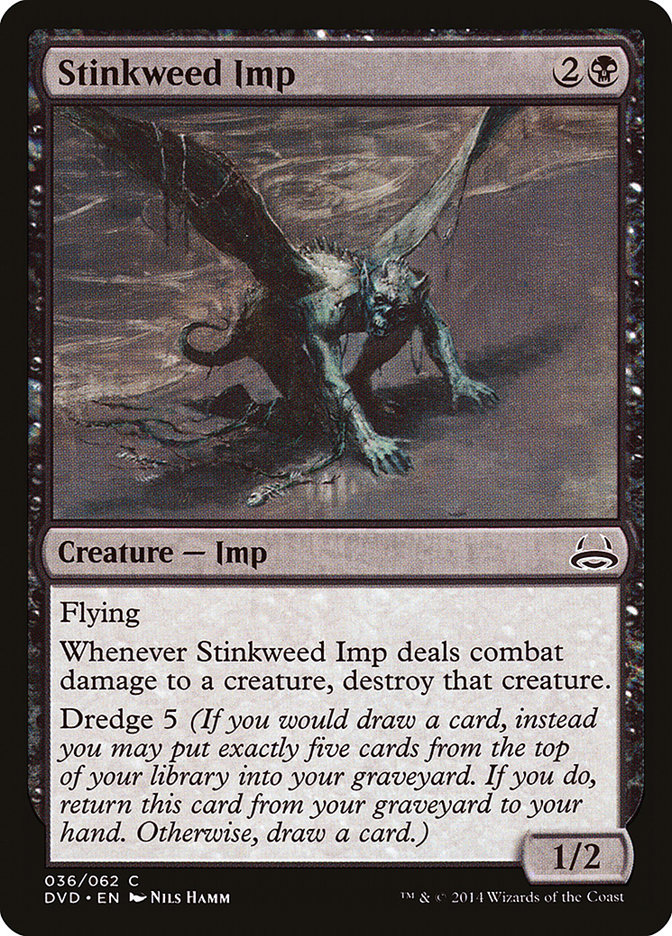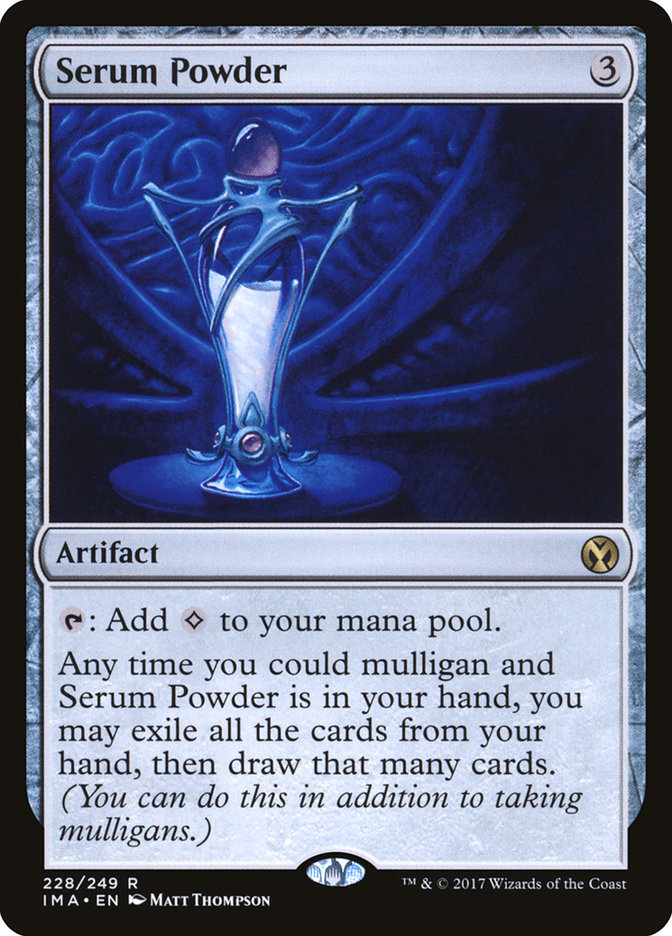I was recently under the false impression that the August 11th Modern Magic
Online Championship Series Playoff was the final event before the cutoff
for the Magic Online Championship, which lead me to over-prepare to try to
avoid finishing on the leaderboard bubble. As a result, I ended up
developing a good sense of the format from relative scratch, ranging all
the way from general dynamics to specific card choices. As such, I’m going
to share my take on the format, along with some of the principles I think
are important for understanding formats in general.
Conceptualizing Modern
The first step to choosing the right deck for a format is producing a
concept of the format to work against.
There’s been discussion recently over whether Modern should or shouldn’t be
understood as a diverse format (see especially Ross Merriam’s
article
and Emma Handy’s
article
). In other words, we’re thinking over whether the mass of known decks in
Modern should be considered competitively viable because any one or another
might be capable of winning a tournament any given weekend, or whether
because there’s a limited selection of decks that seem to be of a higher
calibre than the rest, they should be considered the primary metagame.
Modern is known, of course, for a kind of diversity. Compared to
Standard, there’s a much longer list of decks one might run into during any
given Magic Online League. As the competitive level of the tournament
increases, however, one tends to see this diversity drop, as in the recent
Pro Tour 25th Anniversary, where the top six decks of the format occupied
over 60% of the metagame. Because of the tendency for more serious players
to choose from a narrower range of decks, I’m inclined to see Modern’s
diversity as mostly noise rather than genuine variety.
The key to conceptualizing Modern, then, in my view, is to break it up into
Winner’s and Loser’s circles, and to consider the Loser’s Circle as a
single matchup that a deck can do more or less well against. This provides
a definite metagame one can work at solving, rather than a mess of decks,
each with good and bad matchups. This image of the format doesn’t define
the decks that are indeed viable – it’s just a means of hypothesizing
borderline decks that may be well-positioned to graduate into the winner’s
metagame, or winner’s decks that may be falling out of it.
So, what does Modern look like right now? The most recent major events have
been Pro Tour 25th Anniversary, three weekends ago, and the MOCS Playoff,
two weekends ago. These events established that the Tier 1 definitely
consists of at least U/W Control and Humans. Humans went into the PT as the
expected most popular deck and still had an excellent conversion rate to
top finishes and won the MOCS. U/W Control extended its good showing from
GP Barcelona; looked great on camera all weekend; continues to have a
number of credible proponents; like Luis Salvatto, Joel Larsson, and Mark
Herberholz; and placed second at the MOCS. These decks are at the height of
their Tier 1 status, popular, and definitely good.
Creatures (37)
- 4 Meddling Mage
- 4 Noble Hierarch
- 4 Phantasmal Image
- 4 Champion of the Parish
- 3 Thalia, Guardian of Thraben
- 4 Mantis Rider
- 3 Reflector Mage
- 4 Thalia's Lieutenant
- 4 Kitesail Freebooter
- 3 Militia Bugler
Lands (19)
Spells (4)

Creatures (3)
Planeswalkers (5)
Lands (25)
Spells (27)

In addition, there are several relatively popular decks whose status is
less certain: Hollow One, Ironworks, Mono-Green Tron, R/B Vengevine, Bant
Spirits, and – given its three spots in the Top 8 of the MOCS Playoff –
Hardened Scales Affinity. R/B Vengevine has been a major X factor, with its
actual strength given an optimal build being unknown.
Before trying to make headway on this concept of the format, it’s important
to have an understanding of some specifics.
Specific Impressions of Decks, Cards, and Matchups
When considering a deck, there are two principles to keep in mind. The
first is to aim to exploit the format as a whole. Paul Rietzl recently
expressed this premise as follows:
The big secret to magic is to make the commonly played
interaction not work well against your deck. That’s true in
basically every format.— Paul Rietzl (@paulrietzl)
April
16, 2018
Imagine that every format can be reduced to a common denominator of what
the best decks are trying to do. For example, the Standard metagame at Pro
Tour 25th Anniversary was mainly composed of red and green creature decks
which, although different in the details, were both exploitable by the Bant
Nexus strategy. The way to attack a metagame is to speculate and iterate on
points of vulnerability. This is easier said than done, given that one must
not only beat the best decks at their intended gameplan, but must also
avoid their accidental protections (e.g. sideboard “splash damage”).
Breaking the metagame altogether is usually a proposition that either pays
huge dividends or must be scrapped, but even just trying to position
oneself well can sometimes be difficult.
The second principle, less well-known and providing more incremental value,
is to aim to exploit misunderstood particulars, such as matchups or card
choices. When a matchup or card is evaluated wrongly within the metagame,
this presents an opportunity: as long as this misevaluation is widespread,
the metagame cannot correct itself to adjust for it, and the person who
knows about it can continue to capitalize.
This means that any knowledge you can pick up (“people think X card, or
matchup is good/bad, when in fact its the opposite”) can provide the key
you need to finding a deck that gives you the highest winrate against the
field.
Humans
After trying many decks for the MOCS, I was surprised to settle on Humans,
the “obvious best deck.” I landed here both because I felt several matchups
were misevaluated, and that the build had some small room for improvement.
As for misevaluated matchups, I felt the deck had better matchups against
R/B Vengevine and Hollow One than people appreciated. I spent a lot of time
trying to make R/B Vengevine work, and despite many of its advocates
claiming that the Humans matchup was good, I kept losing to quick flyers,
or even just a wall of four or five big or annoying creatures. And after
sideboard, Auriok Champion was doing a lot of work. I was beating Hollow
One every time, and Auriok Champion was similarly nightmarish for them
after sideboard, especially when multiple copies showed up. Engineered
Explosives is definitely the sideboard card you don’t want to see, but it’s
only ever a one or two-of and hardly determines the game. As well, the
threat of the rise of R/B Vengevine was keeping the metagame from shifting
to be more hostile to Humans, including by disincentivizing generally
undesirable matchups, like Tron and Jund-variants.
As for the list and adjustments, this is what I arrived at:
Creatures (38)
- 4 Meddling Mage
- 4 Noble Hierarch
- 4 Phantasmal Image
- 4 Champion of the Parish
- 3 Thalia, Guardian of Thraben
- 4 Mantis Rider
- 3 Reflector Mage
- 2 Thraben Inspector
- 4 Thalia's Lieutenant
- 4 Kitesail Freebooter
- 2 Militia Bugler
Lands (18)
Spells (4)

The two most notable features here are the two maindeck copies of Thraben
Inspectors and the two sideboard copies of Riders of Gavony.
The Thraben Inspectors are included because I think standard builds of the
deck are short on one-drops – this is because maximizing Aether Vial
requires you to have another one-drop (besides itself) to play on Turn 2,
and so it effectively doesn’t count as a one-drop. Thraben Inspector is
preferable to something like Experiment One because of Humans’ tendency to
get flooded and because even a 1/2 is a decent threat once pumped. The
slight reduction in overall cmc helps justify playing only eighteen land
and a less flood-prone 26 total mana sources.
The Riders of Gavony are typically dismissed because in the mirror they are
at risk of being cloned and because against the field they’re narrow, but I
found both reasons to be overstated. In the mirror, you get to choose when
and if to play the Riders, and because you get the first attack, the play
pattern is often to attack with as many creatures as you can to not die on
the way back, then attack for the win on the following turn. As well, given
the design of Humans to pivot between a disruptive anti-combo deck and a
midrange anti-creature deck, especially after sideboard, Riders is
frequently an asset, effectively negating an opposing creature type for as
long as it sticks around and being much better than Meddling Mage or
Kitesail Freebooter in the relevant matchups. I end up bringing it in a lot
– e.g. in against Hollow One, Bant Spirits, Hardened Scales Affinity,
Elves, and Merfolk.
It’s true that Militia Bugler isn’t going to be grinding anyone out. I like
to think of it as a bit more gas in the tank of a deck that runs light. Two
is a good number for providing a decent chance you’ll be able to copy them
in games where you need to extend the stream of threats a little longer.
-
Auriok Champion is a beast of a sideboard card – one you can lean
on against Burn, Hollow One, and R/B Vengevine, among others, as
well as bring in to decent effect in the mirror – and anyone who
tells you to cut them should be regarded with suspicion. -
Damping Sphere isn’t great, but unfortunately none of your other
anti-combo/control cards do anything in the matchup. It forces them
to have Oblivion Stone, which you can shut out if you have a
Meddling Mage. Gaddock Teeg seems way too narrow to me. -
No Reclamation Sage: This leaves you vulnerable mainly to Worship
out of Bant Spirits and certain G/W decks, and Ensnaring Bridge out
of fringe decks. It’s also an okay card against Affinity. The big
problem with this card is that the value it provides in its optimal
use is diminished by how frequently it’s a blank. The most frequent
appearance of Ensnaring Bridge, as well, is out of Burn decks,
where it’s beatable even without Sage (more on this below).
Tron
I spent a lot of time going back to Tron. The deck is so solid and easy to
play at a basic competitive standard that it has a good winrate right out
of the box, which seems like it should be able to be improved with practice
and tuning. Unfortunately, the gains seem marginal.
Tron turned out to have the following issues:
-
Weak to the R/B Vengeveine threat, although the matchup is
winnable. -
More importantly: it didn’t actually beat U/W Control – in
fact, this might be a very bad matchup!
In terms of our second principle above, then, Tron has the burden of facing
a metagame calibrated as if the deck could beat U/W Control – sideboard
hate, bad matchups, etc. – but doesn’t actually get the value out of its
supposedly good matchup.
I started losing to U/W Control following the recent standardization of the
build with four Field of Ruin.
Somewhere along the line, I went from beating U/W Control every time and
having sideboard Emrakul, The Promised End be an inevitable trump, to
having close pre-sideboard games often lost to a runaway planeswalker and
difficult post-sideboard games where an early Stony Silence was ending the
game immediately for a sizeable range of hands. If a couple Surgical
Extractions becomes standard in U/W Control, I see the matchup becoming
even worse.
Along the way, I made the following adjustments to the list, some of which
might be useful going forward:
-
I added two Gemstone Caverns to the sideboard. Gemstone Caverns
seems generally underplayed to me, given that in a deck that can
support one or two, it can come in versus almost every deck when on
the draw. It seems particularly underplayed in Tron, given that the
deck benefits greatly from acceleration but has almost no way to
get it given its early turns are occupied with filtering. Someone
ended up playing them at the PT, which
the members of /r/TronMTG found to be especially noteworthy
. -
In general, I didn’t like either Thought-Knot Seer or Thragtusk in
the Sideboard. An honest Thought-Knot Seer, as well as the midrange
plan in general, is only mediocre against the matchups you bring it
in against. Thragtusk is better, being a nice supplement against
Hollow One in particular, but again felt too fair to me. I shifted
between the full amount of these and none of them. -
I like the idea of Tarmogoyf instead of Thragtusk, especially with
the emergence of R/B Vengevine since it gives you a real blocker
while you’re struggling to get your mana together. -
The problem with Dismember is that because of the steep life cost,
the only deck it’s really good against is Humans, where it’s useful
to remove specific disruption creatures. This leaves you split
between covering that base and having a relevant card against the
broader range of creature decks. The sideboard spot removal spells
have similar issues, with Warping Wail being particularly weak. -
One option I tried following the rise of R/B Vengevine was four
maindeck copies of Walking Ballista. These double as payoff spells
and early game speedbumps or Bridge from Below removal. In general,
cards that pivot in this way – cheap card selection spells like
Adventuous Impulse for example – still sometimes go undervalued in
Constructed. -
One option I tried to fight back against U/W Control and Field of
Ruins after sideboard was two copies of Crucible of Worlds along
with a Tectonic Edge, which had been a brutally effective strategy
(with Life from the Loam) in Dredge. It seemed good, but not
especially decisive, given that one could still be outrun by an
active planewalker.
The final list I was considering playing was:
Creatures (9)
Planeswalkers (6)
Lands (19)
Spells (26)

Even with the adjustments, however, I wasn’t happy with the matchups
against R/B Vengevine or U/W Control.
R/B Vengevine
I spent a lot of time working on R/B Vengevine in the week before the Pro
Tour, when it was first breaking out.
The deck’s good draws were so explosive, and it beat its good matchups,
like U/W Control, Mono-Green Tron, and Mardu Pyromancer, so badly that it
was very promising. With this many good matchups in or near the Tier 1, the
rest of its matchups only needed to be okay for it to be an excellent
choice, and the deck still had a lot of room for development.
At first, I misunderstood the deck and thought that its keepable hands
could be nearly reduced to those with one of eight payoff cards, one of
about ten enabler cards (discard outlets), and one of seventeen lands, but
that these hands were generally very strong. Accordingly, my first attempt
at improvement was to bolster these numbers. I tried Stinkweed Imps as
additional payoff cards, and Serum Powders as additional mulligan draws
(exiling your mulligan hands usually works out to a slight benefit), both
of which played okay.
On further consideration, though, a Stitcher’s Apprentice paired with
various other cards (another Apprentice, a discard outlet, or a sacrifice
outlet) is also a decent keep, which brought me in line with orthodox
builds. The deck plays as a “Game 1 graveyard deck” that also has the
unusually strong Plan B of shifting into something like “8-Whack” Zoo,
which is especially valuable after sideboard when other graveyard decks,
like Dredge, struggle badly against a single Leyline of the Void.
Ultimately, I found that although the deck’s basic “fail rate” of doing
something relatively broken in the first two turns was tolerable, when this
was combined with the number of times it would lose to a just okay
battlefield, its altogether “flake rate” wasn’t good enough to make it a
Tier 1 choice. The deck would often struggle against big green creatures
(Tarmogoyf, Scavenging Ooze, Knight of the Reliquary), Humans, or flyers,
despite many R/B Vengevine players believing those to be okay or even good
matchups. This fundamental issue seems unaffected by the ongoing small
shifts to the optimal build.
I don’t see the deck breaking into the Tier 1 for the time being.
-
The deck may or may not want further discard outlets beyond the
four copies of Insolent Neonate and Faithless Looting.
Unfortunately, the remaining options aren’t nearly as strong in the
deck. Cathartic Reunion gets rid of two cards but doesn’t suit the
deck’s aggressive posture. Some players at the PT played Bloodrage
Brawler, but I’m not convinced that’s better than Heir of
Falkenrath. Desperate Ravings is almost good enough. Hedron Crab is
an interesting possibility. -
I saw one guy playing Death’s Shadow in the deck, as an expensive
‘egg’ that gets big in the late game. It’s a cute idea, but the
deck seems to be missing a second source of self-damage besides
lands. -
Back when there were lots of mirror matchups, I liked a couple
Goblin Chainwhirlers in the sideboard, which play especially well
during games in which both players have Leyline of the Void. I also
liked them against Storm, which usually shifts to an Empty the
Warrens plan against you.
Burn
In my experience, Burn always sounds better in theory than it plays in
practice. The deck has a focused gameplan, great mana, and good sideboard
options. As well, it seemed relatively well-positioned, with a good matchup
against R/B Vengevine and with Collective Brutality/Tarmogoyf decks largely
scared out of the metagame.
The major issue with Burn is that the deck needs at least two lands to
function, floods at four, and has no card selection to smooth out draws.
And even its good matchups are not overwhelming so. As well, I’ve found the
deck to be terrible against U/W Control with very meagre sideboard
offerings, which is borne out in rough data analysis of the last three Modern Grand Prix.
For Burn to compete for Tier 1 status, it will need a major new addition
along the lines of Sulfuric Vortex.
-
I tried a few cute ideas to help alleviate the flooding problem. I
actually played Dryad Arbor in a Naya build at a GP a few years ago
with four copies of Wooded Foothills and Windswept Heath, and found
it to be great as a way of converting an excess land into about a
Shock’s worth of value. The downside is magnified in a Boros build,
however. The other idea was Mishra’s Bauble which pumps Monastery
Swiftspear and often is, in effect, “0: Scry 1, Draw a card.” The
marginal gain, however, is counteracted or nearly counteracted by
its effect on mulligan decisions. -
Ensnaring Bridge is an interesting sideboard option. As a R/B
Vengevine and Humans player, I was initially terrified of the card,
since I couldn’t justify bringing in potentially dead dedicated
artifact removal spells in a matchup that was all about hustling to
win as soon as possible. As it turns out, Bridge isn’t the
game-ender I thought it was. It’s not a stretch for a Humans player
to have multiple copies of Auriok Champion on the battlefield,
which allows them to get ahead of the burn and then win with a
couple Reflector Mages on stray creatures. And the games that R/B
Vengevine wins are so quick that the deck will often be able to go
under the Ensnaring Bridge, or to nearly do so and then finish with
scrys into Walking Ballista. I haven’t been impressed with
Ensnaring Bridge as a sideboard card, especially when without
playing it you get the equity of opponents potentially boarding for
it.
Conclusions and Predictions
Humans and U/W Control are central to Modern’s top tier. Several other
decks had uncertain value: R/B Vengevine, Mono-Green Tron, Hollow One,
Ironworks, U/W or Bant Spirits, and Hardened Scales Affinity.
-
Given R/B Vengevine’s weakness to Humans and general flakiness, I
see its metagame share diminishing, which will make U/W Control
stronger and Humans weaker. -
Given Hollow One’s mediocre positioning versus U/W Control and
Humans, I see its metagame share diminishing. -
Given Ironworks’ general weakness to a wide range of sideboard
cards that don’t seem to be going anywhere, I see its metagame
share diminishing. It did okay at the PT, but we know that the best
finisher with the deck wasn’t winning a lot on Day 2 and 3, and it
didn’t really show up at the MOCS. -
Given Mono-Green Tron’s poor matchup versus U/W Control, I see it
staying at the fringes of Tier 1. It’s helped by R/B Vengevine’s
decline and how easy Tron is to do well with. -
U/W and Bant Spirits seems competitive against both Humans and U/W
Control. I’ve lost to it my fair share, and Worship is an
outstanding sideboard card. My intuition is that the deck’s power
level is low enough relative to Humans against the field that it
will remain a fringe player. -
Hardened Scales Affinity is my pick for the most potential in the
developing metagame. I hate running into it as a Humans player.
I’ve heard that the U/W Control matchup is not good, but if it can
be made competitive, the deck will be a very solid choice. -
Jeskai is indeed a terrible matchup for Humans. If someone can
build the deck so that it’s competitive against U/W Control, maybe
there’s potential for it to re-emerge as a central player. -
If PGO-Genesis’s Storm deck really does have a good matchup against
Humans and U/W Control, it certainly has promise. So far it hasn’t
made much of a splash at either the PT or the MOCS Playoff. -
Grindy Thoughtseize decks get a boost from the decline of R/B
Vengevine, but only seem mediocre against the core Tier 1, and so
are likely to remain in the background.
The metagame taking shape then looks as though it will have Humans and U/W
Control at its core, with Tron an ever-present but ultimately soft choice,
Bant Spirits and Hardened Scales Affinity as emerging contenders, and Storm
lurking nearby. Ironworks, Hollow One, and R/B Vengevine have good reason
to be on the decline. U/W Control is limited by being among the hardest of
the bunch to pick up and play – which only benefits those who do play it,
since it will be underrepresented in the metagame – and won’t be going
anywhere anytime soon due to being so generally resilient. It just survived
a hostile metagame turn, and there are no obvious sideboard trumps. Humans
is more vulnerable to an adjusting metagame and will likely lose a few
points in the coming weeks.
I think there’s truth to the idea that the Standard metagame at the Pro
Tour is so homogeneous partly due to an echo chamber effect and because
pros lean toward safe choices for major events. In other words, the
Standard Winner’s Circle, at least at the Pro Tour, has been overly closed
to viable challengers. I don’t believe this to be the case in Modern, which
is populated by a larger percentage of casual-competitive players committed
to lower tier decks. You can’t go too wrong by playing a Tier 1 deck in
Modern, which should have a positive winrate against the field from the
start, but your winrate will be maximized by thinking through the
continuing developments at the upper tier of the metagame.


